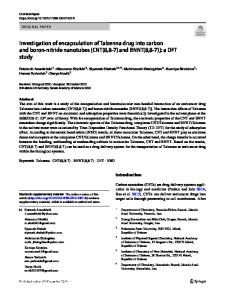TEM Investigation of U 6+ and Re 7+ Reduction by Desulfovibrio desulfuricans , a Sulfate-Reducing Bacterium
- PDF / 1,720,421 Bytes
- 6 Pages / 413.1 x 633.6 pts Page_size
- 67 Downloads / 235 Views
ABSTRACT
2 Uranium and its fission product Tc in aerobic environment will be in the forms of U0 2 + and TcO 4 ". Reduced forms of tetravalent U and Tc are sparingly soluble. As determined by transmission electron microscopy, the reduction of uranyl acetate by immobilized cells of Desulfovibrio desuifuricansresults in the production of black uraninite nanocrystals precipitated outside the cell. Some nanocrystals are associated with outer membranes of the cell as revealed
from cross sections of these metabolic active sulfate-reducing bacteria. The nanocrystals have an average diameter of 5 nm and have anhedral shape. The reduction of Re 7' by cells of Desulfovibrio desulfuricans is fast in the media containing H2 electron donor, and slow in the media containing lactic acid. It is proposed that cytochrome in these cells has an important role in the reduction of uranyl and Re7+ that is a chemical analogue for one uranium fission product 2 Tc7+ through transferring electron from molecular hydrogen or lactic acid to the oxyions of UO 2 + and ReO4 ". INTRODUCTION The solubility of uranium and Tc is dependent on their oxidation state. U4' and Tc 4' are sparingly soluble. Under oxidizing environments, uranium will exist in the form of uranyl (U0 22+) ion that complexes with carbonate (C0 32-) and organic ligands. When carbonate is present in aerobic solutions, uranyl forms highly soluble metal complexes of U0 2CO30 , U0 2(CO 3)2a, and U0 2(CO3)34 [1]. Waste water from the nuclear industries are important because oxidative dissolution of nuclear waste and uranium fission product Tc results in the formation of very soluble oxy-ions, such as of UO 22+, TcO4 -, and PuO 221. In order to immobilize the uranium in water, uranium may be reduced to insoluble uraninite (U0 2). Recent studies have demonstrated that Desulfovibrio desulfuricans and other sulfate-reducing bacteria are capable of reducing uranyl and other metals by enzyme-mediated reactions [2-8]. This biological processe involving reduction of heavy metals can effectively remove from solution. The detoxification process is known as dissimilatory reduction and occurs when electrons from molecular hydrogen (H2 ) or lactate are transferred to oxidized metal ions such as selenate [9], or UO 22+ [5]. In at least 299 Mat. Res. Soc. Symp. Proc. Vol. 608 © 2000 Materials Research Society
one instance, the dissimilatory reduction of uranyl ion is coupled to the growth of a sulfatereducing bacterium, Desulfotomaculumreducens [10]. It is very difficult to Immobilize Tc in aerobic environment, because Tc 7÷ in the form of TcO 4" is very stable in solution. In this report, we also use sulfate-reducing bacteria of Desulfovibriodesulfuricansto reduce ReO 4 ",a chemical analogue for
Tc0 4"
using electron donors
of lactate and hydrogen gas. Based on the similarity of redox potentials of Re0 4" and Tc04" [1], the bacteria that can reduce ReO4- may be able to reduce TcO4". CULTURE, SAMPLE PREPARATION, AND EXPERIMENTAL METHODS Culture for Uranium Reduction Bacteria used in the experi
Data Loading...











